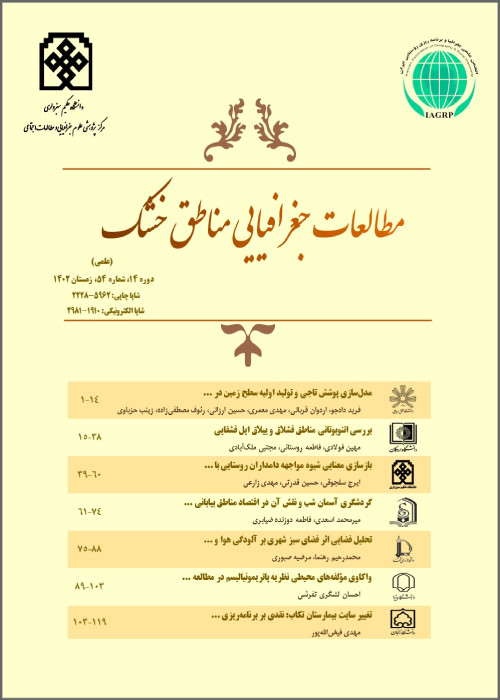Investigating the Effect of Land Use Intensity on Environmental Sustainability of Transportation in Mashhad
Author(s):
Article Type:
Research/Original Article (دارای رتبه معتبر)
Abstract:
Introduction
Urban density includes population density, density of residential areas and employment density In addition, net and gross density are one of the most important determinants of the travel patterns of residents, which can be determined the type and extent of using personal and public transport and consequently the amount of CO2 emission. Kockelman (1997) states that the significance of the compaction index in relation to travel behavior can be as large as the density index as representative, and in the top of the other indicators of the urban form. On the other hand, Ewing and Cervero (2010) studies show that the VMT or VKT is the best indicator for measuring the effect of different types of densities as independent variables on energy consumption in daily trips. And its impact is so high that the per-capita correlation coefficient (VMT) and CO2 emissions are approximately equal to 1, and the per-capita correlation coefficient (VMT) and nitroxid emission are equal to 0.74.The main goals of this paper are to find out what statistical relations and correlations exist in Mashhad between the main types of urban densities and the per capita of VKT. And which types of density can have the greatest effect on reducing VKT? What is the situation of 15th traffic areas in Mashhad in terms of carbon emission of private vehicles? How much the urban densities can impact on carbon emission reduction?
Materials and Methods
The research method is based on quantitative strategy and descriptive-analytical method. This paper has been used to analyze the behavior of residents' travel and its impact on the emission of pollutants from the dependent variable VKT. Also, the urban densities variables such as population density, employment density and non-residential employment density residential blocks density and land use density, which indicate the intensity of land use, were considered as independent variables.The data needed to measure VKT was conducted from the results of origin-destination census analysis in Mashhad, 2011. By accessing the results of this survey and measuring the average distance between the origin and destination of private cars in each region, VKT was obtained for each region.
Discussion and Results
The findings show that urban areas with a density of more than 100 hectares of VKT are 2.5 to 4 km less than densities below 100 hectares. By reducing density from the central regions to the margin, the average travel distance increases. In the case of population density variable, the correlation coefficient was -0.557 and P-value = 0.02 which suggests that "there is a significant indirect relationship between increasing the density of regions and reducing the distance of personal car journeys at a significant level of 0.05". In addition to population density, employment density is also very effective in reducing VKT. In addition to population density, employment density is also very effective in reducing VKT and the correlation coefficient was -0.79 (P-value = 0.00) between these two variables at a significant level of 0.01. "There is also a significant relationship (correlation coefficient = 0.656 and P-value = 0.008), between the density of residential blocks in each region and the vehicle kilometer travel of the residents in each area.
The fourth type of density is the application of mixed land use density .The results of the correlation between this variable and VKT shows that there is a significant relationship between the increase in the diversity of land use and the reduction of VKT. This correlation coefficient for the city of Mashhad is equal to 0.552 (p-value =0.03). Finally, we calculated the amount of carbon released by the each traffic zone and by using the influence coefficients which obtained from the multiple regression equation; we calculated the carbon reduction in the case of increasing density. The highest emissions of carbon contaminants are in areas that are not in a desirable situation of land use intensity. These areas, meanwhile, are more dependent on automobiles
Conclusions
In this paper, four types of densities including population density, employment densities, residential block densities, and mix land use density were considered. And finally, it was revealed that although all four types of densities have a linear relationship with the vehicle kilometer traveled (VKTs). However, only 2 variables including non-resident employment density and density of residential blocks are significant in regression model. Also, by calculating the amount of carbon released by the segments of the 15 traffic areas, it was found that the low carbon approach to transportation of the city of Mashhad in the area of urban densities should be emphasized by employment densities, because business trips have a larger share of personal trips than other travel destinations.Keywords:
Language:
Persian
Published:
Arid regions Geographic Studies, Volume:8 Issue: 29, 2017
Pages:
1 to 16
magiran.com/p1982620
دانلود و مطالعه متن این مقاله با یکی از روشهای زیر امکان پذیر است:
اشتراک شخصی
با عضویت و پرداخت آنلاین حق اشتراک یکساله به مبلغ 1,390,000ريال میتوانید 70 عنوان مطلب دانلود کنید!
اشتراک سازمانی
به کتابخانه دانشگاه یا محل کار خود پیشنهاد کنید تا اشتراک سازمانی این پایگاه را برای دسترسی نامحدود همه کاربران به متن مطالب تهیه نمایند!
توجه!
- حق عضویت دریافتی صرف حمایت از نشریات عضو و نگهداری، تکمیل و توسعه مگیران میشود.
- پرداخت حق اشتراک و دانلود مقالات اجازه بازنشر آن در سایر رسانههای چاپی و دیجیتال را به کاربر نمیدهد.
In order to view content subscription is required
Personal subscription
Subscribe magiran.com for 70 € euros via PayPal and download 70 articles during a year.
Organization subscription
Please contact us to subscribe your university or library for unlimited access!


